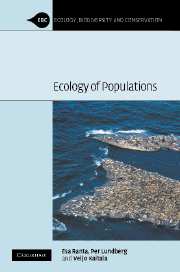Book contents
- Frontmatter
- Contents
- Preface
- 1 Introduction
- 2 Population renewal
- 3 Population dynamics in space – the first step
- 4 Synchronicity
- 5 Order–disorder in space and time
- 6 Structured populations
- 7 Biodiversity and community structure
- 8 Habitat loss
- 9 Population harvesting and management
- 10 Resource matching
- 11 Spatial games
- 12 Evolutionary population dynamics
- 13 Epilogue
- References
- Index
- References
References
Published online by Cambridge University Press: 02 December 2009
- Frontmatter
- Contents
- Preface
- 1 Introduction
- 2 Population renewal
- 3 Population dynamics in space – the first step
- 4 Synchronicity
- 5 Order–disorder in space and time
- 6 Structured populations
- 7 Biodiversity and community structure
- 8 Habitat loss
- 9 Population harvesting and management
- 10 Resource matching
- 11 Spatial games
- 12 Evolutionary population dynamics
- 13 Epilogue
- References
- Index
- References
- Type
- Chapter
- Information
- Ecology of Populations , pp. 338 - 367Publisher: Cambridge University PressPrint publication year: 2005



